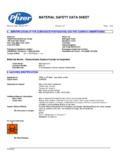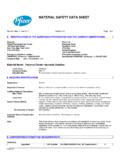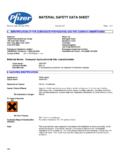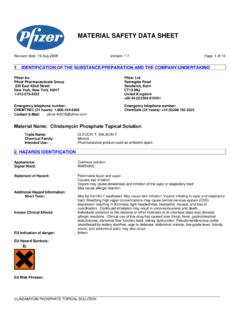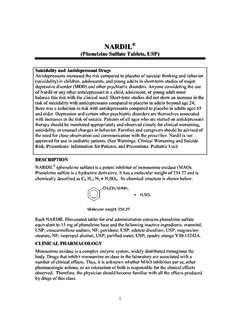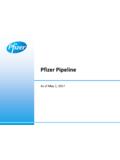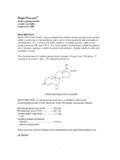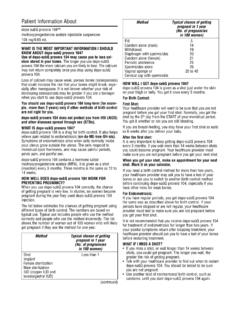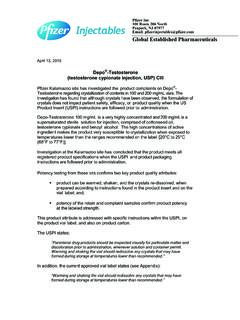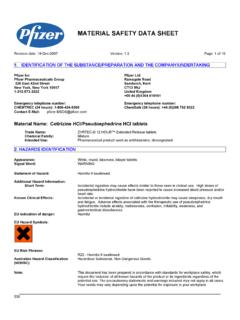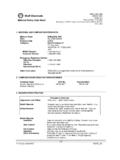Transcription of MATERIAL SAFETY DATA SHEET - Pfizer
1 Page 1 of 7 Revision date: 02-Jan- 2007 MATERIAL SAFETY data SHEET Version: IDENTIFICATION OF THE SUBSTANCE/PREPARATION AND THE COMPANY/UNDERTAKING MATERIAL Name: Cisplatin Solution for Injection - and 1 mg/ml Trade Name: Platamine; Cisplatino; Cisplatine; Platiblastin; Plastisil; Platiblastin S Chemical Family: Mixture Intended Use: Pharmaceutical product used as Antineoplastic 2. COMPOSITION/INFORMATION ON INGREDIENTS HazardousIngredientCAS NumberEU EINECS List% Acid7647-01-0231-595-7**Sodium hydroxide1310-73-2215-185-5** IngredientCAS NumberEU EINECS List%Sodium chloride7647-14-5231-598-3*Water for Injection7732-18-5231-791-2*Mannitol69-6 5-8200-711-8* Additional Information:* Proprietary ** to adjust pH Ingredient(s) indicated as hazardous have been assessed under standards for workplace SAFETY . 3. HAZARDS IDENTIFICATION Appearance:Clear to light yellow solution - mg/mlClear solution - 1 mg/mlSignal Word:WARNING Statement of Hazard:Possible carcinogen and mutagenAdditional Hazard Information: Short Term: May cause eye and skin irritation; May be fatal if swallowed (based on components) Long Term: Repeat-dose studies in animals have shown a potential to cause adverse effects on kidneys and blood and blood forming organs.
2 Animal studies have shown a potential to cause adverse effects on the fetus. Known Clinical Effects: Effects on blood and blood-forming organs have also occurred. EU Indication of danger:Mutagenic Category 2 Carcinogenic: Category 2 Pfizer Ltd Ramsgate Road Sandwich, Kent CT13 9NJ United Kingdom +00 44 (0)1304 616161 Emergency telephone number:CHEMTREC (24 hours): 1-800-424-9300 Emergency telephone number: ChemSafe (24 hours): +44 (0)208 762 8322 Pfizer Inc Pfizer Pharmaceuticals Group 235 East 42nd Street New York, New York 10017 1-212-573-2222 MATERIAL SAFETY data SHEET _____ MATERIAL Name: Cisplatin Solution for Injection - and 1 mg/mlRevision date: 02-Jan- 2007 Page 2 of 7 Version: Hazard Symbols: EU Risk Phrases: R45 - May cause cancer. R46 - May cause heritable genetic damage. Note: This document has been prepared in accordance with standards for workplace SAFETY , which require the inclusion of all known hazards of the active substance or its intermediates regardless of the potential risk.
3 The precautionary statements and warnings included may not apply in all cases. Your needs may vary depending upon the potential for exposure in your workplace. 4. FIRST AID MEASURES Eye Contact:Immediately flush eyes with water for at least 15 minutes. If irritation occurs or persists, get medical attention. Skin Contact:Remove clothing and wash affected skin with soap and water. This MATERIAL may not be completely removed by conventional laundering. Consult professional laundry service. Do not home launder. If irritation occurs or persists, get medical attention. Ingestion:Get medical attention. Do not induce vomiting unless directed by medical personnel. Never give anything by mouth to an unconscious person. Inhalation:Remove to fresh air. If not breathing, give artificial respiration. Get medical attention. 5. FIRE FIGHTING MEASURES Extinguishing Media: Use carbon dioxide, dry chemical, or water spray. Hazardous Combustion Products: Formation of toxic gases is possible during heating or fire.
4 Fire Fighting Procedures: During all fire fighting activities, wear appropriate protective equipment, including self-contained breathing apparatus. Fire / Explosion Hazards: Not applicable 6. ACCIDENTAL RELEASE MEASURES Health and SAFETY Precautions: Personnel involved in clean-up should wear appropriate personal protective equipment (see Section 8). Minimize exposure. Measures for Cleaning / Collecting: Contain the source of spill if it is safe to do so. Collect spill with absorbent MATERIAL . Clean spill area thoroughly. Measures for Environmental Protections: Place waste in an appropriately labeled, sealed container for disposal. Care should be taken to avoid environmental release. Additional Consideration for Large Spills: Non-essential personnel should be evacuated from affected area. Report emergency situations immediately. Clean up operations should only be undertaken by trained personnel. MATERIAL SAFETY data SHEET _____ MATERIAL Name: Cisplatin Solution for Injection - and 1 mg/mlRevision date: 02-Jan- 2007 Page 3 of 7 Version: HANDLING AND STORAGE General Handling: Eliminate possible ignition sources ( , heat, sparks, flame, impact, friction, electricity), and follow appropriate grounding and bonding procedures.
5 Avoid contact with eyes, skin and clothing. Avoid breathing vapor or mist. Use with adequate ventilation. Storage Conditions: Store at controlled room temperature. Protect from light. 8. EXPOSURE CONTROLS / PERSONAL PROTECTION Analytical Method: Analytical method available for cisplatin. Contact Pfizer Inc for further information. Engineering Controls: Engineering controls should be used as the primary means to control exposures. Local exhaust ventilation is required unless used in a closed system. Personal Protective Equipment: Hands:Rubber gloves Eyes: SAFETY glasses or goggles Skin:Wear protective clothing with long sleeves to avoid skin contact. Wash hands and arms thoroughly after handling this product. Respiratory protection:If the applicable Occupational Exposure Limit (OEL) is exceeded, wear an appropriate respirator with a protection factor sufficient to control exposures to below the OEL. 9. PHYSICAL AND CHEMICAL PROPERTIES: 10.
6 STABILITY AND REACTIVITY Stability:Stable under normal conditions of use. OSHA - Final PELS - TWAs:2 mg/m ACGIH Threshold Limit Value (TWA)= mg/m3 TWA = 1 mg/m3 TWA ACGIH Ceiling Threshold Limit:= 2 mg/m3 Ceiling Physical State: Sterile solution Australia PEAK = 2 mg/m3 PeakColor: Clear to Light yellow ( mg/ml); clear (1 mg/ml)Molecular Formula: Mixture Australia TWA Molecular Weight:Mixture= mg/m3 TWA = 1 mg/m3 TWAC isplatinHydrochloric Acid ACGIH Ceiling Threshold Limit:= 2 ppm Ceiling OSHA - Final PELS - TWAs:= mg/m3 TWA Australia PEAK = 5 ppm Peak = mg/m3 PeakSodium hydroxide MATERIAL SAFETY data SHEET _____ MATERIAL Name: Cisplatin Solution for Injection - and 1 mg/mlRevision date: 02-Jan- 2007 Page 4 of 7 Version: to Avoid:None knownIncompatible Materials:As a precautionary measure, keep away from strong oxidizers. 11. TOXICOLOGICAL INFORMATION General Information:The information included in this section describes the potential hazards of the individual ingredients.
7 Acute Toxicity: (Species, Route, End Point, Dose)Irritation / Sensitization: (Study Type, Species, Severity) Repeated Dose Toxicity: (Duration, Species, Route, Dose, End Point, Target Organ)Reproduction & Developmental Toxicity: (Study Type, Species, Route, Dose, End Point, Effect(s))Sodium chlorideRat Intravenous LD 50 mg/kgSkin Irritation SevereEye Irritation SevereRat Oral LD50 3000 mg/kgSodium chlorideEye Irritation Rabbit ModerateMouse Oral LD 50 4000 mg/kgMouse Oral LD 50 mg/kgSkin Irritation Rabbit MildCisplatinMannitolCisplatin5 Day(s) Dog Intravenous mg/kg/day LOAEL KidneyRat Oral LD 50 13500 mg/kgMouse Intravenous LD 50 11 mg/kg5 Day(s) Non-human Primate Intravenous mg/kg/day LOAEL Kidney5 Day(s) Non-human Primate Intravenous mg/kg/day LOAEL KidneyMouse Oral LD 50 22 g/kg5 Week(s) Non-human Primate Intravenous mg/kg/day LOAEL KidneySodium hydroxide11 Week(s)
8 Rat Intraperitoneal 1 mg/kg/day LOAEL KidneyRat Oral LD 50 mg/kgSodium chlorideSodium hydroxide10 Day(s) Rat Oral 12500 mg/kg LOAEL Kidney, Ureter, BladderEye Irritation Rabbit SevereMouse IP LD50 40 mg/kgSkin Irritation Rabbit SevereHydrochloric Acid MATERIAL SAFETY data SHEET _____ MATERIAL Name: Cisplatin Solution for Injection - and 1 mg/mlRevision date: 02-Jan- 2007 Page 5 of 7 Version: Toxicity: (Study Type, Cell Type/Organism, Result)Carcinogenicity: (Duration, Species, Route, Dose, End Point, Effect(s)) Carcinogen Status: See below 12. ECOLOGICAL INFORMATION Environmental Overview: Environmental properties have not been thoroughly investigated. Releases to the environment should be avoided. 13. DISPOSAL CONSIDERATIONS Disposal Procedures: Dispose of waste in accordance with all applicable laws and regulations. 14. TRANSPORT INFORMATIONNot regulated for transport under USDOT, EUADR, IATA, or IMDG regulations.
9 IARC:Group 3In Vivo Sister Chromatid Exchange Mouse Bone Marrow PositiveEmbryo / Fetal Development Rat Intravenous mg/kg/day LOAEL FetotoxicityEmbryo / Fetal Development Mouse Intraperitoneal 3 mg/kg LOAEL Fetotoxicity, TeratogenicCisplatin8 Month(s) Mouse Intraperitoneal mg/kg/week LOAEL Lungs, Tumors52 Week(s) Mouse Intraperitoneal mg/kg/week LOAEL Skin, TumorsCisplatinEmbryo / Fetal Development Rat Intraperitoneal mg/kg LOAEL Fetotoxicity, Developmental toxicity15 Month(s) Rat Intraperitoneal 1 mg/kg (3x/week) LOAEL Bone marrow, Kidneys, Malignant tumorsIn Vitro Chromosome Aberration Human Lymphocytes PositiveIn Vivo Chromosome Aberration Mouse Bone Marrow PositiveCisplatinEmbryo / Fetal Development Rabbit Intraperitoneal mg/kg LOAEL FetotoxicityCisplatin IARC:Group 2A - Probably Carcinogenic to HumansBacterial Mutagenicity (Ames) Salmonella Positive NTP:Reasonably Anticipated To Be A Carcinogen OSHA:PresentDominant Lethal Assay PositiveHydrochloric AcidEmbryo / Fetal Development Rat Intraperitoneal mg/kg/day LOAEL Fetotoxicity, Developmental toxicity MATERIAL SAFETY data SHEET _____ MATERIAL Name: Cisplatin Solution for Injection - and 1 mg/mlRevision date: 02-Jan- 2007 Page 6 of 7 Version: 15.
10 REGULATORY INFORMATION EU Symbol:T EU Indication of danger:Mutagenic Category 2 Carcinogenic: Category 2 EU Risk Phrases: R45 - May cause cancer. R46 - May cause heritable genetic damage. EU SAFETY Phrases: S22 - Do not breathe dust. S53 - Avoid exposure - obtain special instructions before use. S36/37 - Wear suitable protective clothing and gloves. OSHA Label: WARNINGP ossible carcinogen and mutagen Canada - WHMIS: Classifications WHMIS hazard class:Class D, Division 2, Subdivision A EU EINECS List239-733-8 California Proposition 65 Listed: CancerSodium chloride Inventory - United States TSCA - Sect. 8(b)Present Australia (AICS):PresentInventory - United States TSCA - Sect. 8(b)Present EU EINECS List231-598-3 Hydrochloric Acid Australia (AICS): CERCLA/SARA 313 Emission reporting= % de minimis concentration acid aerosols including mists, vapors, gas, fog, and other airborne forms of any particle sizePresentCisplatin CERCLA/SARA Hazardous Substances and their Reportable Quantities:= 2270 kg final RQ = 5000 lb final RQ CERCLA/SARA - Section 302 Extremely Hazardous TPQs= 500 lb TPQ gas only Standard for the Uniform Scheduling for Drugs and Poisons: Schedule 4 MATERIAL SAFETY data SHEET _____ MATERIAL Name: Cisplatin Solution for Injection - and 1 mg/mlRevision date: 02-Jan- 2007 Page 7 of 7 Version: 16.
